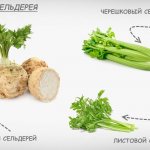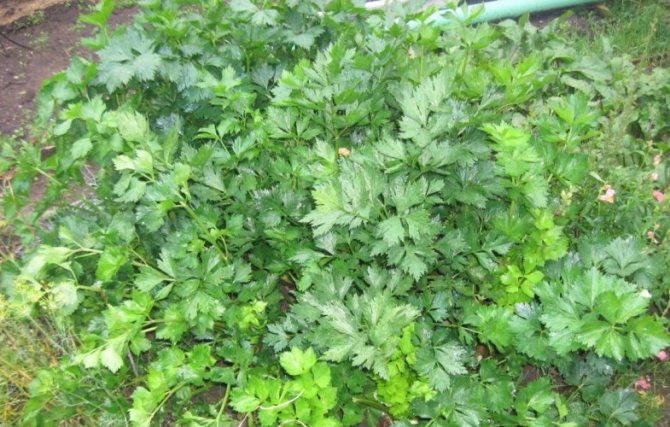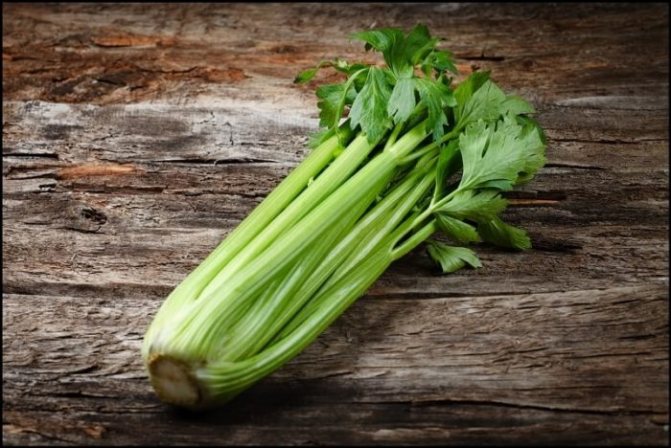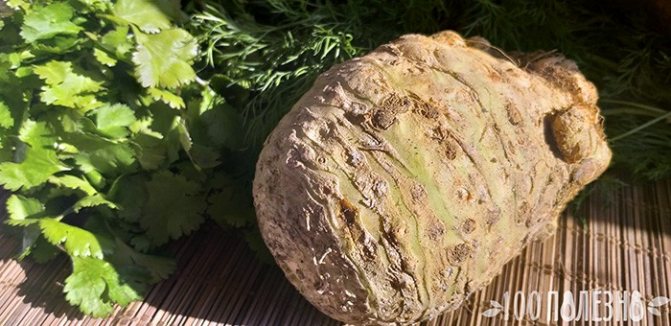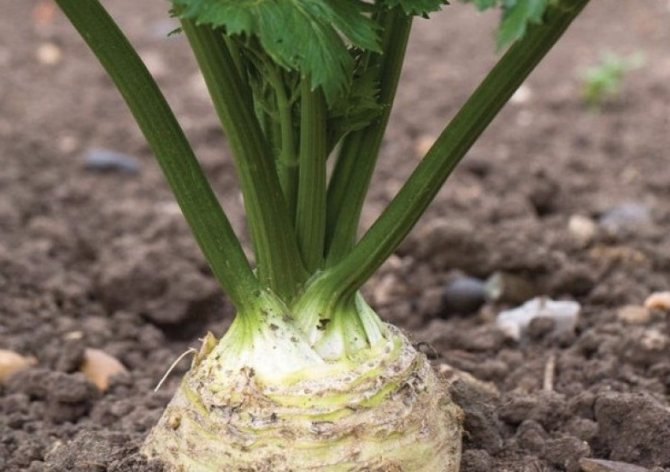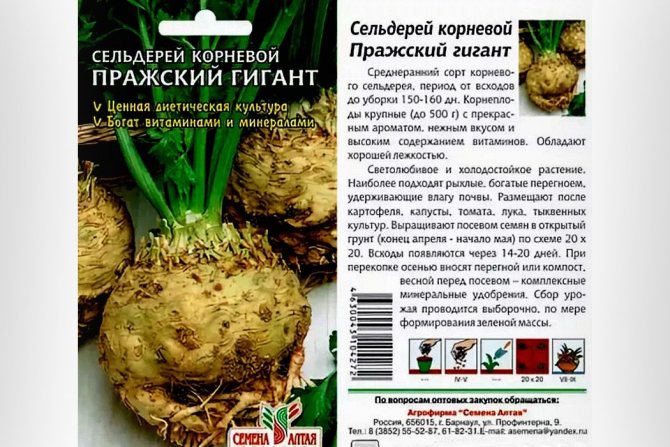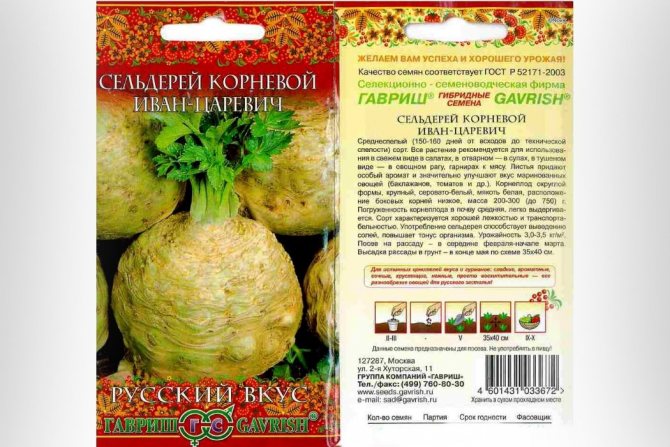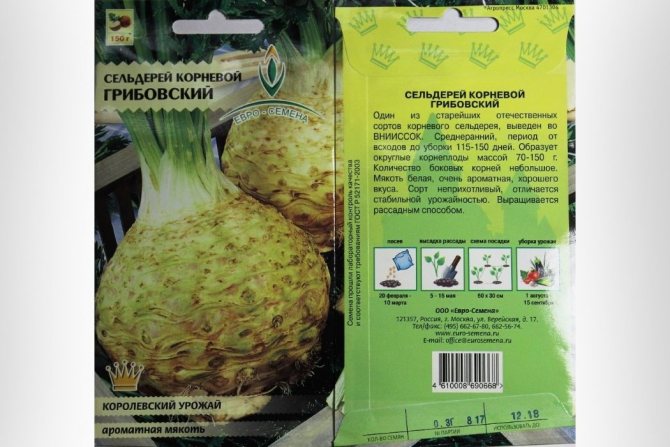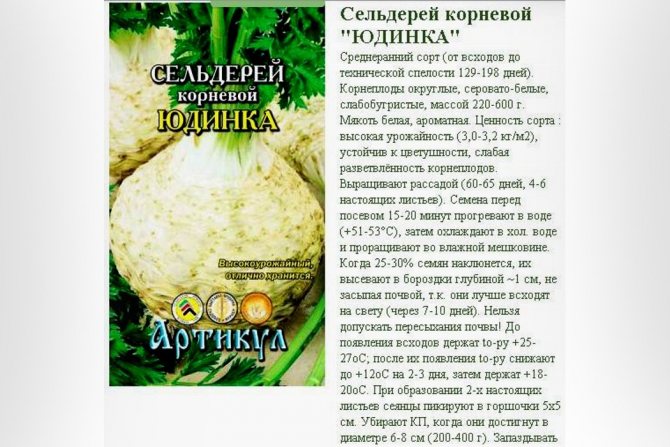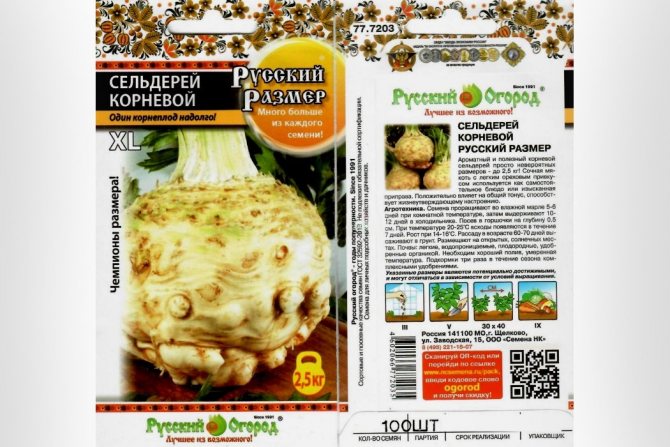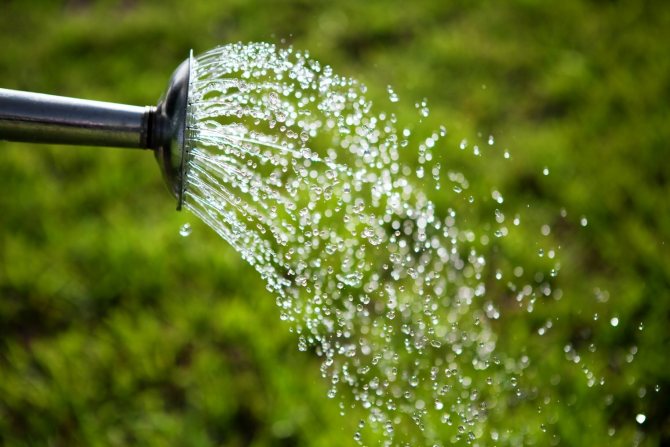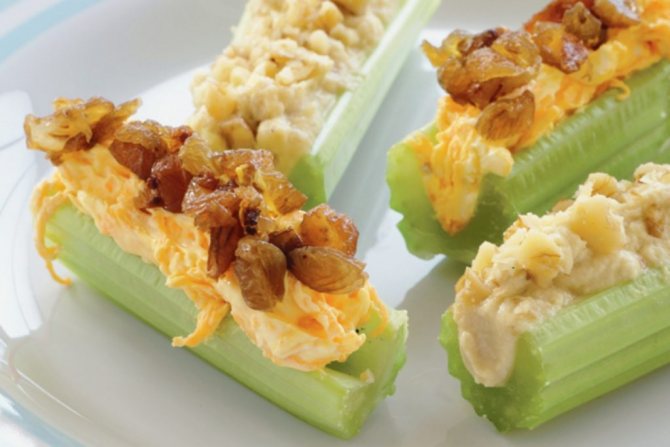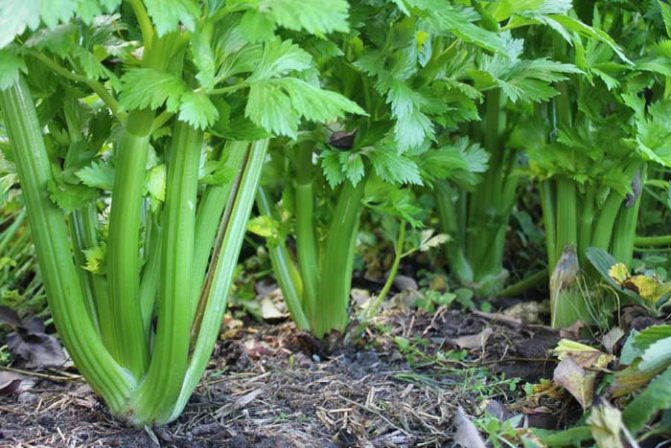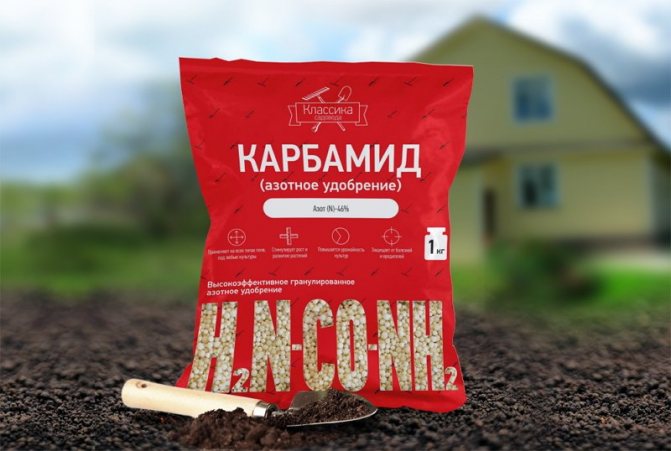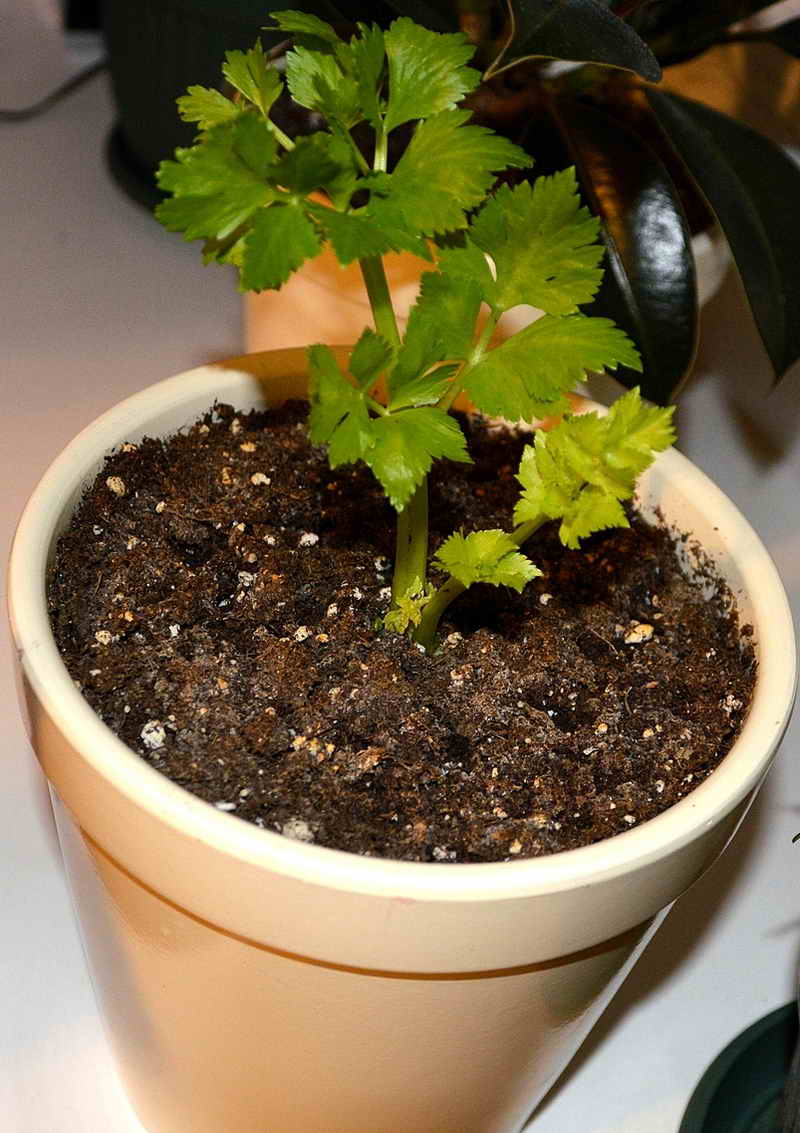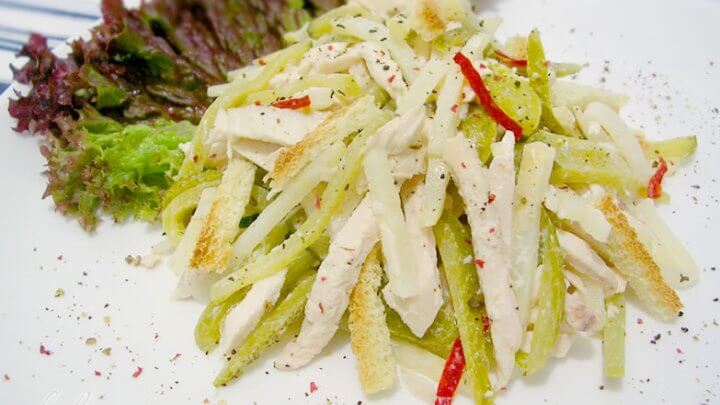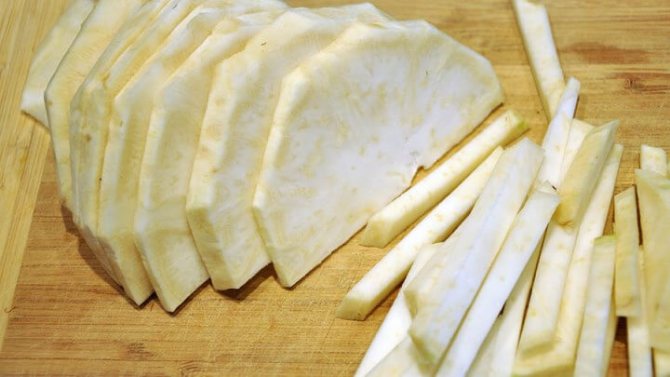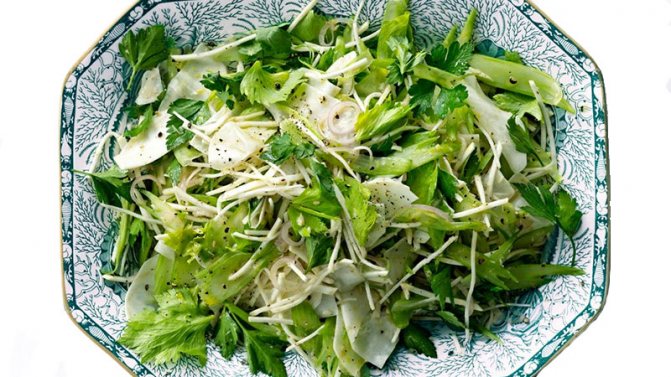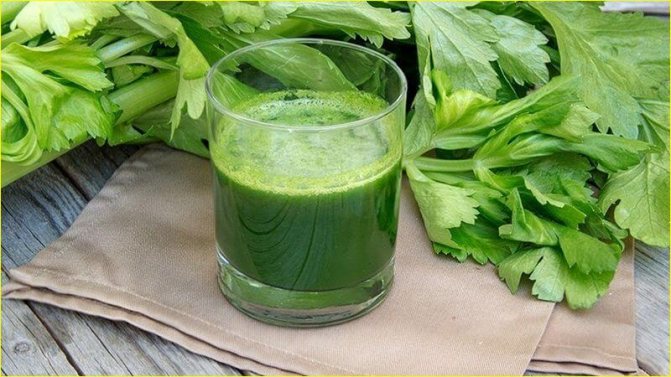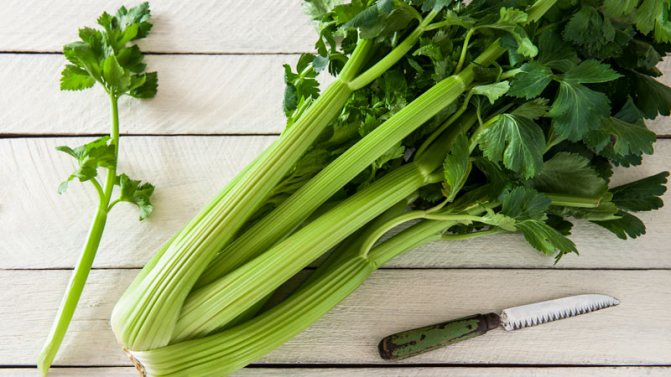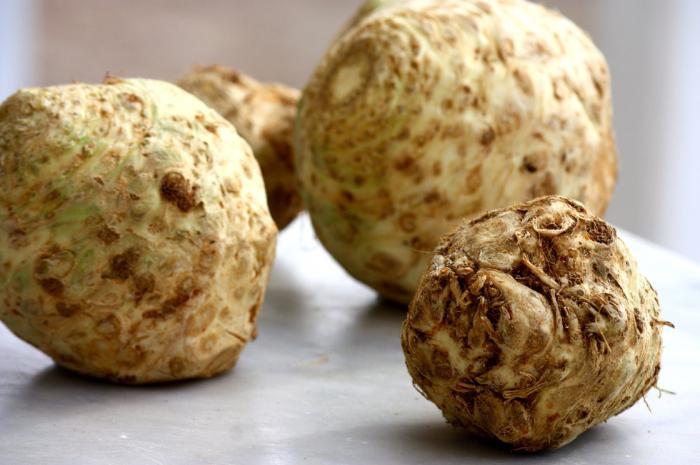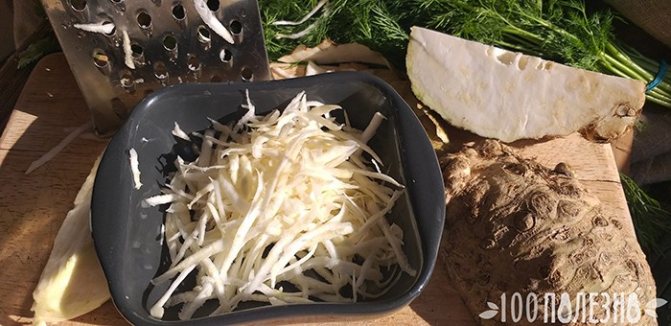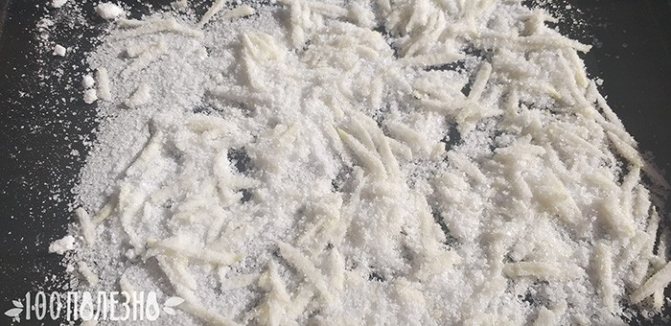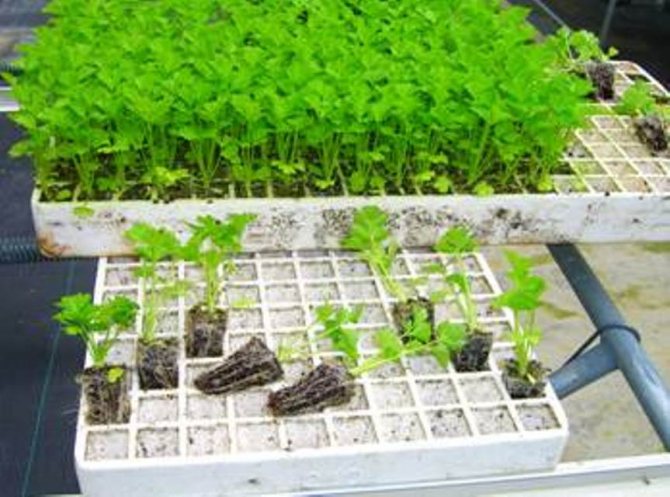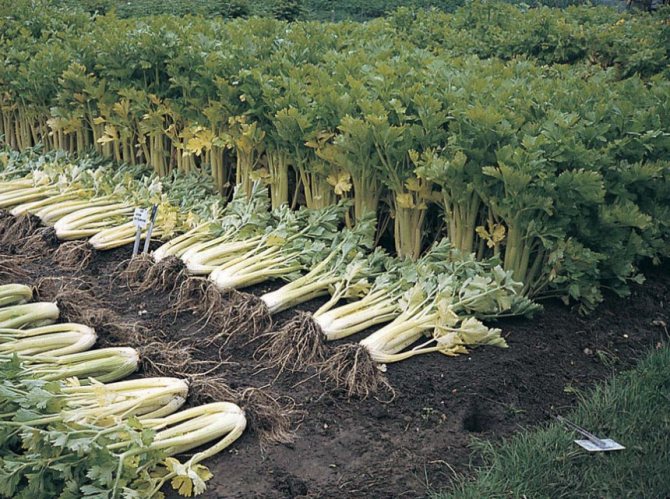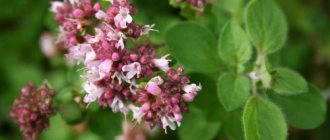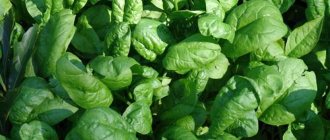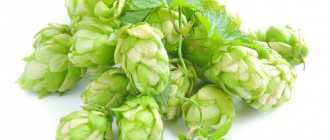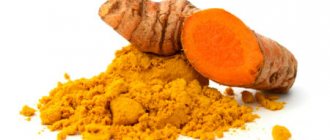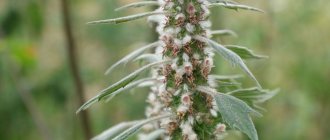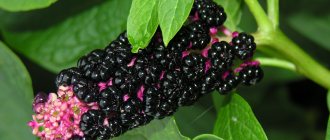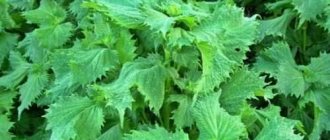Celery is represented by three types: root, petiole and leaf. It is grown for greens, juicy stalks, or for the sake of fleshy root vegetables. The resulting products are used as a separate product, as an ingredient for dishes, and processed. Each species has many varieties, which are described in the article.
Celery is a vegetable with a spicy scent and pungent taste
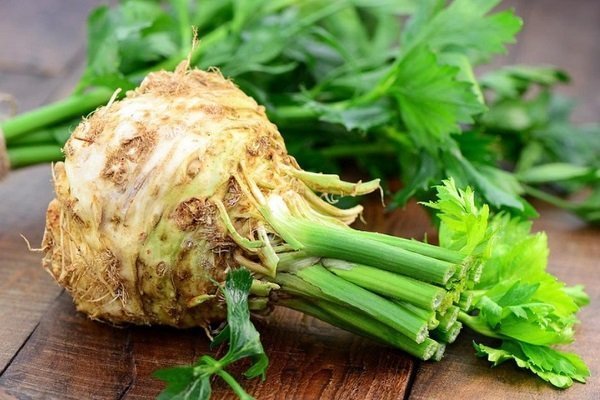
Root celery forms a small leafy rosette and a round-angular root crop the size of a fist. The root vegetable is rubbed and added to meat dishes
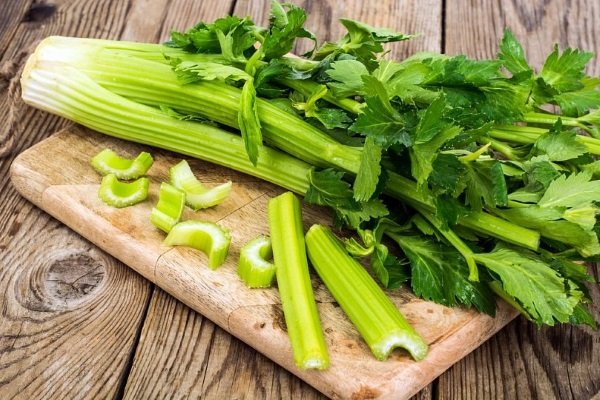

Petiolate celery varieties have thick and juicy stems, but they do not form a root crop. This type of celery is used in fresh salads.
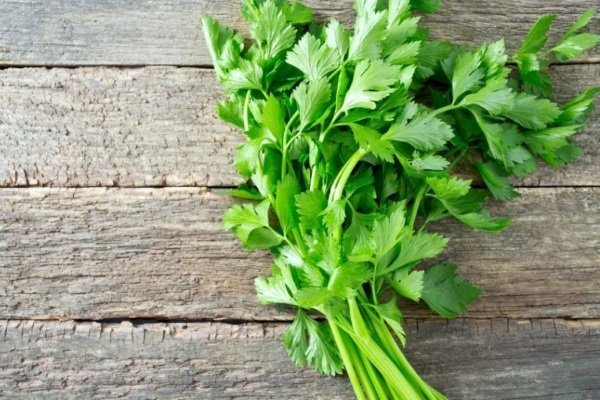

Leafy (curly) celery looks like parsley: it does not form a root crop, the stems are thin, the leaves are lush. Greens are used in the preparation of first and second courses, dried for later use in winter
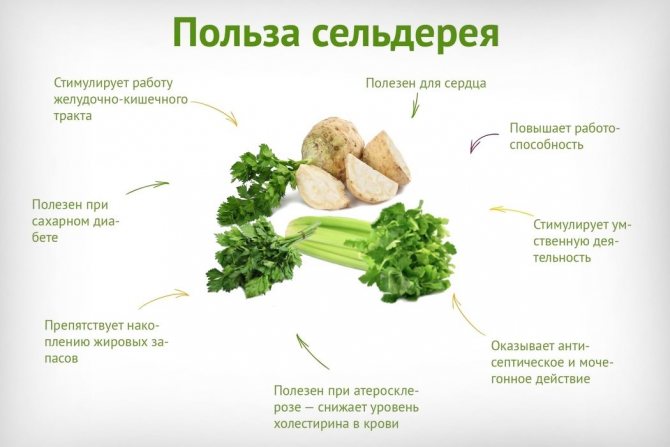

Useful properties of celery
What is celery?
Celery is a green vegetable that is grown for its aromatic and juicy stems, roots and leaves, but it is most in demand as a condiment with a characteristic strong spicy aroma and a pleasant bittersweet taste.
All parts of celery can be eaten, its leaves, root, as well as stems and seeds are used as a spice in cooking in European and Asian cuisine.
What does celery look like - photo
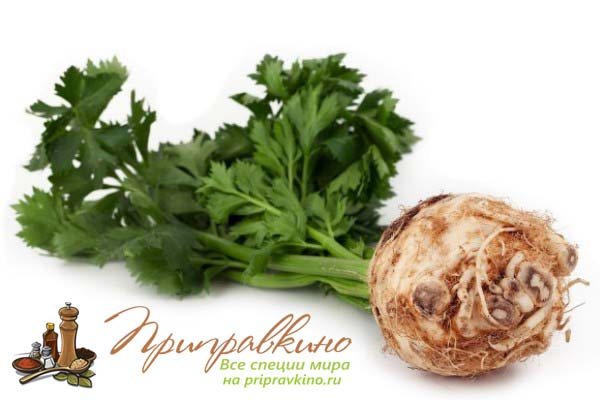

The root looks hairy, uneven and brown. However, if cleaned, it becomes smooth and white.
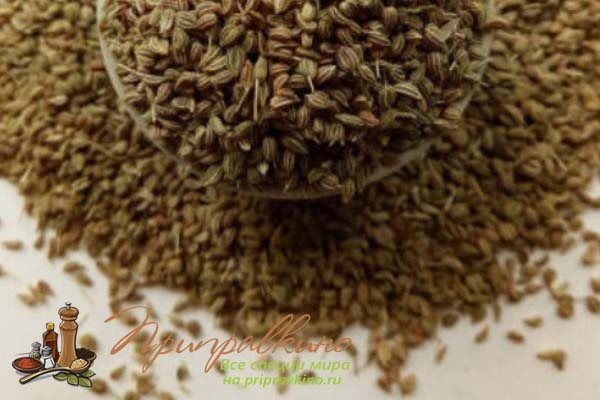

Celery seeds are similar in appearance to caraway seeds. They have a dark brown color, an oblong shape with thin vertical ribs and a very strong aroma.
general description
It is quite powerful, up to 1 m in height, annual or biennial plant with large leaves on long petioles, branched stems and a powerful root system.
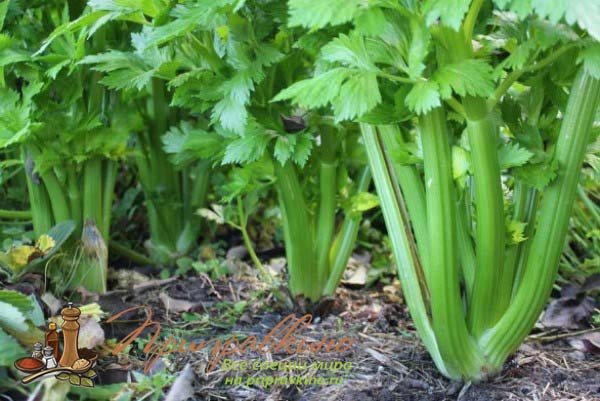

Belongs to the Apiaceae family, which also includes parsley, carrots, fennel, coriander, parsnip, cumin and others. Its other names are: celery, aromatic parsley.
The most famous species is aromatic celery (Apium graveolens).
In this plant variety, two other important types of celery stand out:
- Root - with a large, fleshy root, which is especially prized for its unique nutty flavor. The rhizome is rounded, about the size of an apple, with a very strong pleasant aroma. The scientific name of this species is Apium graveolens var. Rapaceum.
- Leafy (Apium graveolens var. Secalinum) which is very similar to parsley, but tastes like celery. Forms a developed rosette of delicate leaves of bright green color.
Regardless of which species you choose to buy or grow, the benefits can be found in all parts of the plant, including leaves, stems, roots, and seeds. They are all used for food, both fresh and dried.
Traditional medicine recipes
The green part, the seeds have anti-inflammatory and diuretic effects, therefore it is used for edema. The drugs treat diseases of the kidneys and urinary tract and urolithiasis. Boil the greens, insist and squeeze the juice out of it.Decoctions and infusions are well tolerated by patients, since they have a diuretic effect with low toxicity.
- For a diuretic decoction you will need seeds (2 tbsp. l.) and boiling water (1 tbsp.). Boil over low heat for 30 minutes and drink 2-3 tbsp before meals. l.
- Infusion for cystitis: roots fresh and chopped (1 tbsp. l.) are placed in a saucepan with cold boiled water (1.5 tbsp.) and covered with a lid, kept for 4 hours and separated from the thick. They drink 1 tbsp 30 minutes before meals. l.
- For skin diseases boil seeds (1 tsp) in a glass of water (1 minute), insist for half an hour, filter and drink 1 tbsp before meals. l.
- From painful wounds, ulcers make pain relievers: crushed leaves (1/2 tbsp.) pour vinegar (1/2 tbsp.), add sea salt (1/2 tsp.). The mixture is moistened with a napkin and applied to the sore spot.
- From purulent and long-healing wounds: Rub a fresh celery leaf with butter (unsalted) and apply as a compress.
- From articular rheumatism: make up a collection of oregano and celery leaves (1 tsp each), coltsfoot and raspberries (2 tsp each). Boil 2 tbsp. l. in 2 st. boiling water for 5 minutes and separated from the thick. Drink a hot broth for ½ tbsp. 3-4 times / day.
- From thrombophlebitis prepare an ointment: grind the leaves and mix with vegetable oil or butter until sour cream.
How is this seasoning obtained?
To obtain fleshy cuttings and leaves, celery is grown as an annual crop, and for roots and fruits - as a biennial crop.
Greens are harvested mechanically several times per season, when the leaves or cuttings are fully formed. The greens are cut, cleaned, removing damaged, yellow, rotten parts and packaged.
In autumn, after the dying off of the ground part, rhizomes are formed.
The roots left before winter or re-planted in spring continue to grow for the second year, and bloom in June-July, the fruits (seeds) ripen in early autumn. Usually, umbrellas with unripe fruits are cut off and kept for several days in the shade until fully ripe. Then they are threshed and cleaned of stalks, stem parts and debris.
Benefits for men
Celery has a beneficial effect on men's health. Petiolate stimulates the production of the male hormone androsterone, which enhances potency and libido. Regular consumption of the root and leaves normalizes blood pressure and rejuvenates the body, reduces irritability, soothes and improves memory.
Women
Celery is recommended for women to maintain the natural beauty of the skin, hair and nails, reduce body fat, normalize metabolism and water-salt balance.
The plant has a negative calorie content - the body spends more energy on its processing than it receives. Due to this feature, leaves, petioles and root are included in low-calorie diets. Celery juice reduces the vascular network on the legs, reduces the likelihood of developing varicose veins.
Children
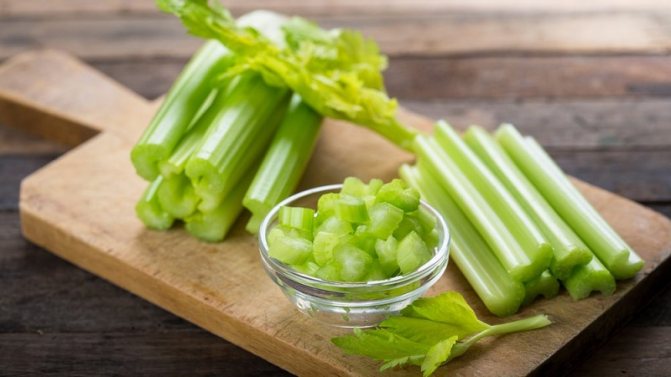

Celery is good for the growing body. Greens, root and stems are allowed to be introduced into the baby's diet, starting from 7 months. By this time, the digestive system will be ready to digest fiber.
Moderate use of the product in childhood:
- promotes rapid regeneration of damaged skin;
- improves digestive function;
- increases iron levels;
- relieves pain;
- removes uric acid salts;
- stimulates appetite;
- has a mild sedative effect.
How to choose celery
Shop for fresh bouncy leaves and bright green petioles. Avoid shriveled stems, withered, yellow, and rotten leaves. The darker the color, the stronger the flavor.
Quality celery seeds of grayish-green or light brown color, of the same size, with a strong characteristic odor without extraneous or chemical tones.The spice should not contain rotten, moldy or insect-damaged fruits, as well as a large number of stalks, stems, leaves, split fruits, debris. The seeds should not crumble when pressed.
Celery root may not look very pretty, but it is tasty and versatile. Choose firm and heavy roots for their size. Small ones are more delicate than large ones, which can be very fibrous. If there are greens or stems in the upper part, they should be fresh, not dried, not slimy, not wilted.
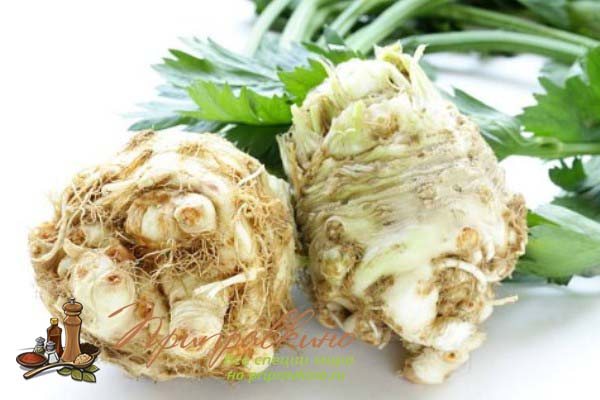

Celery is known for being exposed to many pesticides. Be sure to wash it thoroughly. Buy organic products whenever possible.
Diseases, pests and control of them
Celery is often attacked by pathogenic fungi and pests. Often the cause is errors in care, first of all, excessive thickening of the plantings, too abundant watering, irregular weeding, too frequent fertilization or exceeding the recommended dose.
Diseases typical of the culture:
- Rust. The underside of the leaves, petioles, the lower part of the stem is covered with small "fleecy" spots of bright saffron color. Gradually they grow and "thicken", changing color to copper or rusty. The affected parts of the plant turn yellow and dry. For the prevention of celery, they are sprayed with a solution of Fitosporin-M, Baktofit about once a month. Having found the first symptoms, any fungicides are used - Topaz, HOM, Horus, Kuprozan. At an early stage of the development of the disease, 2-3 treatments are sufficient with an interval of 5-7 days. All chemicals are discontinued 20–25 days before harvest.
- Septoria (white spot). Most often it develops towards the end of summer. Leaves and petioles are covered with small rounded "depressed" spots. On the leaves they are yellowish, on the stems they are dark brown. At the first sign, Topsin-M or Fundazol is used. Processing is carried out twice with an interval of 10-12 days.
- Cercosporosis. The spread of the pathogenic fungus is facilitated by sudden changes in temperature, damp and cold weather. The leaves are covered with numerous rounded light gray spots with a darker border. Gradually, they are tightened with an ink-purple bloom. For treatment, the same drugs are used as for the fight against septoria.
- Downy mildew (downy mildew). A whitish bloom appears on the leaves and stems, similar to scattered flour. Gradually, it thickens, turning into something similar to felt. For prevention, the plants are powdered with colloidal sulfur about once a month, and every week they are sprayed with infusion of soda ash, horsetail or sow thistle. Sick celery is treated with a 2% solution of Bordeaux liquid, Oxyhom, Ridomil-Gold. Usually 2-3 procedures are sufficient with an interval of 8-10 days.
- Cucumber mosaic. Light green or yellowish patches appear on the leaves. They can be in the form of spots, stripes or rings. There are currently no cures for the virus. Affected plants are removed from the garden and burned. The soil is disinfected by spilling it with a 2% solution of copper sulfate or bright pink - potassium permanganate. The virus is spread by spider mites and aphids, so special attention must be paid to combating them.
- White rot. A white bloom similar to cotton wool appears on celery, with small black blotches. Then the bases of the leaves and the top of the tuber soften, acquiring a dark brown hue. They are slimy to the touch, an unpleasant putrid smell appears. Excess nitrogen in the soil contributes to the development of the disease. For the prevention of celery, they are powdered weekly with crushed chalk, sifted with wood ash. Having found a disease, they cut off all even minimally affected parts of the plant.Then it is sprayed three times with an interval of 5–8 days with a solution of any fungicide (Topaz, Abiga-Peak, Skor). Water for irrigation for 2-3 weeks can be replaced with a pale pink solution of potassium permanganate.
Photo gallery: how celery diseases manifest
To combat rust, any fungicides are used. Septoria on celery appears towards the end of summer.
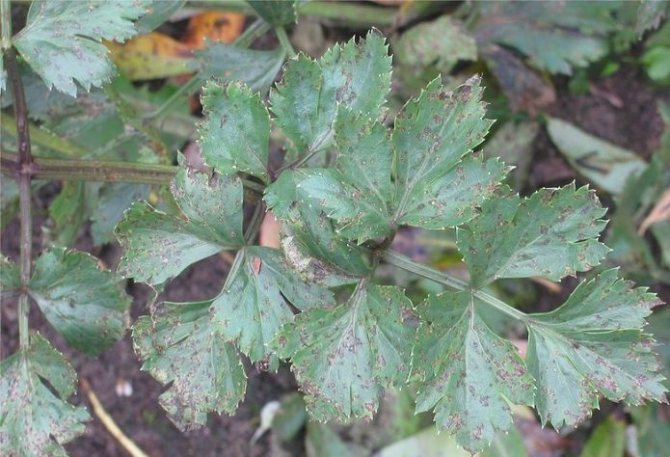

The development of the fungus that causes cercosporosis is facilitated by high air humidity and cool weather.
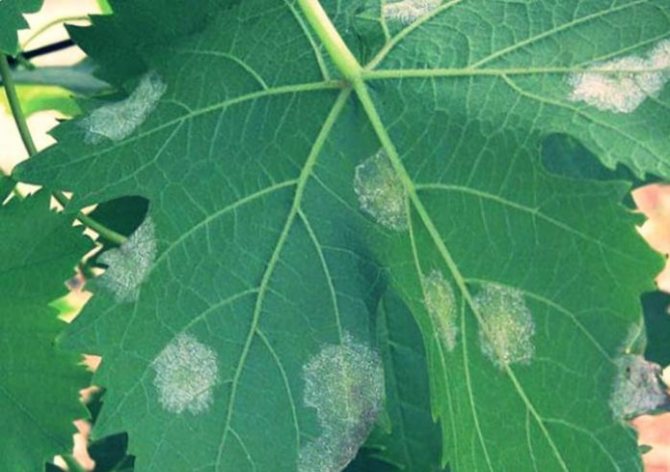

Downy mildew seems to be a harmless coating that can be easily erased, but this is by no means the case.
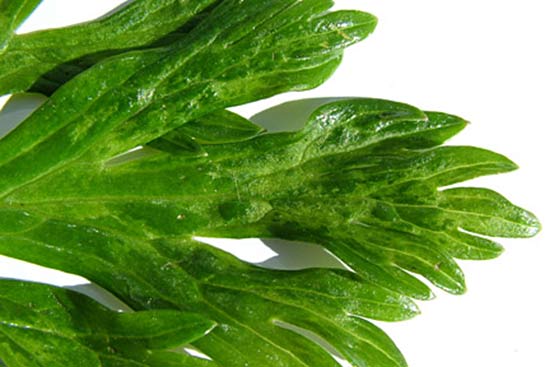

It is impossible to cure cucumber mosaic with modern means.
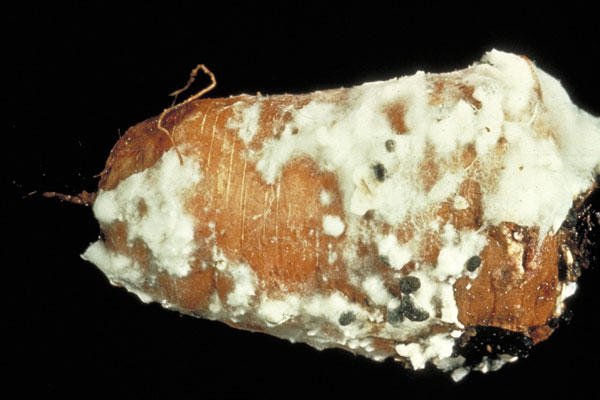

White rot can develop both in the garden and during storage of celery.
Of the pests for celery, the following are the most dangerous:
- Celery fly. Adults lay eggs in leaf tissue. The emerging larvae eat out the petioles from the inside, leaving longitudinal passages in them. The pulp acquires a bitter taste, the yield drops sharply. To scare off adults, the celery garden is surrounded by plantings of onions or garlic. Once every 2-3 weeks, the plants are sprayed with infusion from their arrows or gruel.
- Carrot fly. Lays eggs in soil. The larvae gnaw at the roots of celery, eat out tubers and petioles from the inside, and damage the leaves. To scare them away, the garden bed is sprinkled with a mixture of fine sand, mustard powder and tobacco dust every 7-10 days.
- Carrot beetle. Winters on coniferous trees. In the middle of summer it flies to celery, feeds on plant sap. The affected leaves are deformed, the petioles are shortened, bent. Control measures are the same as for carrot fly.
- Bean aphid. Black insects clinging to the underside of leaves, petioles and stems. They feed on plant sap, the affected parts discolor, deform and dry out. In addition, aphids are a carrier of many dangerous fungi, bacteria, viruses. It is effectively scared off by any infusions with a pungent odor. They are prepared using arrows of onion or garlic, lemon peel, wormwood, tomato tops, hot peppers and so on as raw materials. For prevention, celery is sprayed once a week, for aphid control - 3-4 times a day. If folk remedies do not help, insecticides are used - Inta-Vir, Aktellik, Admiral, Mospilan, Iskra-Bio.
Photo gallery: what celery pests look like
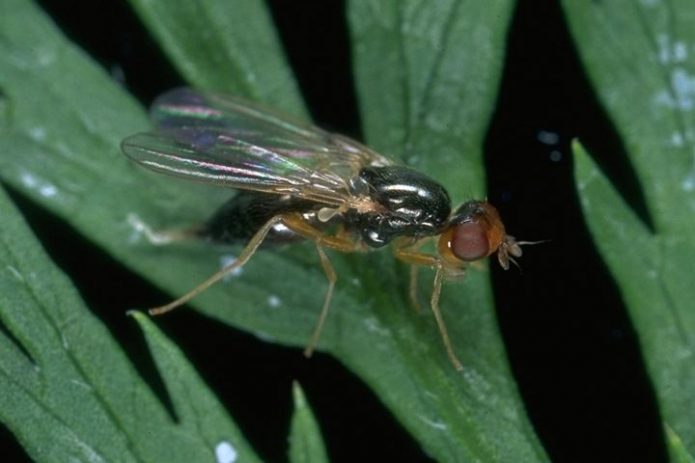

The main harm to plantings is caused by the larvae of the celery fly, but this does not mean that adults do not need to fight


Carrot fly can rob the grower of a significant portion of the celery crop


Most often, celery, growing in garden plots located near coniferous forests, suffers from carrot lice.


Aphids are one of the most "omnivorous" garden pests, celery, too, does not pass by
How and how much to store celery
Celery root retains its properties well for several months if kept in a cool, dark place. Put it in the refrigerator wrapped in a plastic bag. Do not wash or peel the celery root before storing - peeled vegetables quickly oxidize and deteriorate. The sticky soil helps the roots stay fresh longer.
Celery greens cannot be stored at room temperature, as moisture will quickly evaporate from it, which will lead to wilting within a few hours. Place the celery in the vegetable compartment of the refrigerator for no more than two weeks.
All parts of the plant retain their odor well when dried. At home, it is better to dry the leaves in the shade, cut the roots into strips and dry in the oven at a low temperature or in an electric dryer for vegetables. Dried celery has a shelf life of up to two years if stored in hermetically sealed containers.
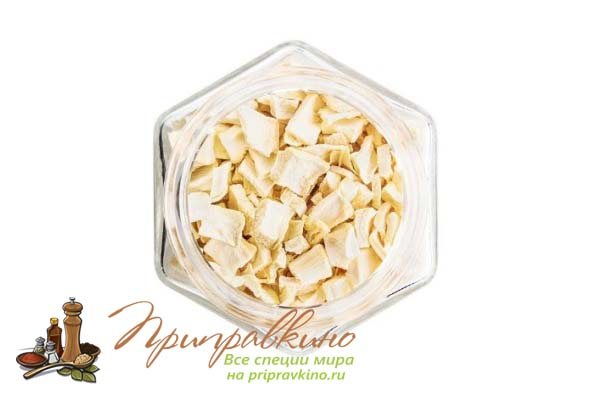

It is convenient to store the petioles frozen.
How to freeze celery
- Wash it thoroughly to remove dirt. Remove rough parts and those that have changed color.
- Cut the petioles into a shape that will be convenient for you to use for soups or stews. This will make it easier to work with frozen food in the future.
- Dip chopped celery in boiling water for three minutes, then chill immediately in a bowl of ice water. You can skip this step if you use frozen celery within two months. But for longer storage, blanching will stop the enzymatic processes on the plant and destroy bacteria and mold.
- Spread the celery on a baking sheet and place in the freezer for several hours.
- Pack it for freezer storage: put it in a plastic bag or plastic container. Think ahead of how you will use it and pack it in portions that will suit your future meals. Be sure to stick the date on which you froze the celery.
With this method of freezing, use it within 12-18 months.
Store frozen celery that has not been blanched for more than two months.
Benefits of celery for women
It is widely known that most of the females, who closely monitor the slimness of their figure, are often engaged in counting calories consumed. It is worth noting that celery dishes are just the perfect solution for any diet. One hundred grams of this vegetable contains only thirteen calories! But is it the only thing that celery can benefit women?
All the most useful qualities and probable restrictions on the consumption of the root of this interesting plant are stored specifically in its “insides”. It contains a whole list of all sorts of usefulness that can improve the external condition of the body, for example, nails, hair or skin.
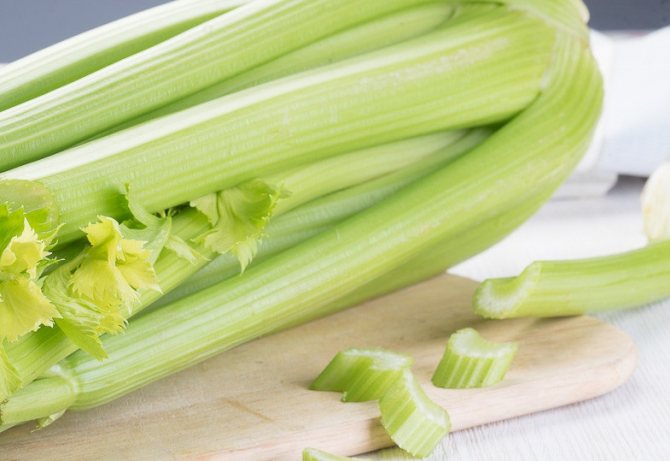

Celery completely normalizes hormones, reduces the risk of mood swings during premenstrual syndrome, and also helps in relieving pain during the main period of menstruation.
There is apiol in its root itself. It increases the frequency of discharge during menstruation, so it is better not to eat celery root if menstruation is already heavy. For the same reason, the vegetable does not need to be eaten closer to the end of the period of bearing a child, by chance, childbirth did not start ahead of time.
It is recommended to exclude celery from the diet of pregnant women. Moreover, you should avoid the consumption of stalked celery. If the risk of termination of pregnancy is identified, then leaf varieties must also be removed from the diet. The substances contained in the plant increase the tone of the uterus, as a result of which you can face extremely undesirable consequences.
Chemical composition
Nutritional value of fresh celery (Apium graveolens) per 100 g.
| Name | number | Percentage of daily allowance,% |
| Energy value (calorie content) | 16 Kcal | |
| Carbohydrates | 3 g | 5,5 |
| Protein | 3.46 g | 6 |
| Fats | 1.12 g | 4,5 |
| Dietary fiber | 2.10 g | 5,5 |
| Folates | 36 mcg | 9 |
| Niacin | 0.320 mg | 2 |
| Pantothenic acid | 0.246 mg | 5 |
| Pyridoxine | 0.074 mg | 6 |
| Riboflavin | 0.57 mg | 4 |
| Thiamine | 0.021 mg | 2 |
| Vitamin A | 449 IU | 15 |
| Vitamin C | 3.1 mg | 5 |
| Vitamin K | 29.3 mcg | 24 |
| Sodium | 80 mg | 5 |
| Potassium | 260 mg | 5,5 |
| Calcium | 40 mg | 4 |
| Copper | 0.35 mg | 4 |
| Iron | 0.20 mg | 2,5 |
| Magnesium | 11 mg | 3 |
| Manganese | 0.103 mg | 4,5 |
| Phosphorus | 24 mg | 3 |
| Zinc | 0.13 mg | 1 |
| Carotene-ß | 270 mcg | — |
| Lutein Zeaxanthin | 283 mcg | — |
general description
Celery is a biennial cold-resistant plant of the Umbrella family, numbering about twenty species.
Today this vegetable is cultivated everywhere. The most popular are its types such as leaf, petiole and root. The last type was especially liked by housewives and gourmets. The thing is that it forms a fleshy, well-developed root crop. But we can see such luxurious varieties only on the pages of publications devoted to gardening and gardening, because such "handsome men" do not grow in our area. The largest root crop reaches the size of a man's fist.
Celery root has a very aromatic and delicate pulp. There are simply no alternative vegetables in nature. The plant owes such enviable characteristics to the exceptional substances that make up its composition.From time to time, celery is even placed on a par with the medicinal properties of ginseng.
Health Benefits of Celery
Celery is one of the lowest calorie plants, therefore it is valued as an effective weight loss aid. Its leaves contain only 16 calories per 100 g of weight, as well as a lot of insoluble fiber (fiber) useful for digestion, which, when combined with other methods of weight loss, will help to reduce body weight and regulate blood cholesterol levels.
Experts say celery has a negative calorie content. This means chewing this vegetable burns more calories than it contains, making celery one of the best weight loss foods out there. This is due to the high content of dietary fiber, which consume calories during digestion.
Celery leaves are a good source of flavonoid antioxidants like zeaxanthin, lutein, and beta-carotene, which have immune-boosting properties.
This plant is also high in vitamin A - 100 grams of fresh celery contains 449 IU or 15% of the daily required level. It is a natural antioxidant that is essential to maintain healthy mucous membranes and skin and to support vision. Consuming natural foods rich in flavonoids helps the body defend against lung and oral cancer.
Celery is rich in many vital vitamins, including folate (providing 9% of the RDI), riboflavin, niacin, and vitamin C, which are essential for proper metabolism.
Fresh celery is an excellent source of vitamin K, which helps increase bone mass by promoting osteoblastic activity. It also has a positive effect on Alzheimer's patients by limiting neuronal damage in the brain.
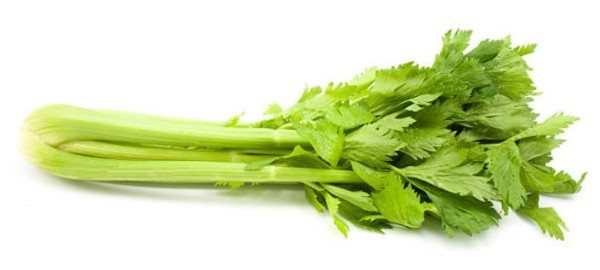

This spice is a very good source of minerals such as potassium, sodium, calcium, manganese and magnesium. Potassium is an important component of cells and body fluids that help regulate heart rate and blood pressure.
Celery leaves and seeds contain many important essential oils that include terpenes, mainly limonene (75 to 80%), and sesquiterpenes such as ß-selenene (10%) and humulene.
The unique aroma of celery is associated with chemical compounds known as phthalides (butylphthalide and its dihydro-derivative sedanenolide).
The essential oil obtained from the extraction of celery has been used as a sedative for anxiety, osteoarthritis, and gouty arthritis.
The seeds and roots have diuretic, stimulating and tonic properties, and they also aid in the secretion of breast milk.
Celery's high water and electrolyte content prevents dehydration, and the compounds present in celery make it work as a diuretic and reduce bloating.
The benefits of fresh celery
So, here are some of the health benefits you get when you add celery to your daily diet:
- Cancer prevention. The polyacetylene compounds present in celery are chemically protective and prevent cancers such as breast, lung, bowel, colon, pancreatic and leukemia cancers. It boosts the immune system, thereby preventing mutated cells from proliferating and tumor growth.
- A source of flavonoids. The bioactive flavonoids in celery, apigenin and luteolin, fight free radicals in the body and kill cancer cells, depriving them of food for growth and reproduction. The antioxidant flavonoids and polyphenolic phytonutrients in celery improve liver, skin, eye and mental health.
- Prevents cardiovascular disease.Pharmacological studies have proven that the beneficial antioxidant and anti-inflammatory properties of celery improve blood pressure and cholesterol levels, and prevent many types of heart disease.
- Reduces blood pressure. Modern scientific research confirms the benefits of celery for lowering blood pressure, which have long been used in traditional medicine. This is due to its potassium and phthalide content, compounds that relax the muscles around the arteries. Coumarin, another antioxidant in celery, increases the activity of leukocytes. Celery has a diuretic effect, so it plays a role in eliminating excess body fluids.
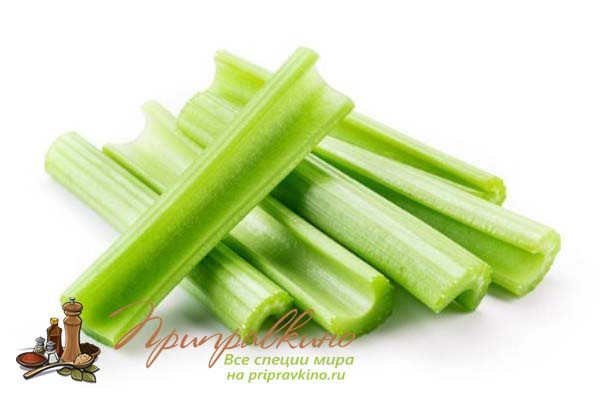

Health Benefits of Celery Seeds
Celery seeds also have health benefits associated with a variety of nutrients they contain:
- Other phytochemicals in celery seeds include limonene, coumarin and apigenin. They provide health benefits by fighting inflammation, which increases the risk of cancer, heart disease, and other problems.
- One teaspoon of the seeds of this spice provides 35 mg of calcium and 0.9 mg of iron, as well as 0.5 mg of manganese. The mineral content is relatively low compared to the daily requirement, but quite significant given the small number of seeds.
- Celery seeds are rich in flavonoids. These are antioxidants that provide pigmentation in plants and prevent cell damage.
The seeds of this plant are used to treat conditions such as:
- Arthritis.
- Gout.
- Muscle spasms.
- Anxiety.
- High blood pressure.
Research also shows that celery seeds are an effective mosquito repellent.
How celery can benefit
Due to the richness of its own composition, it may well have a general strengthening effect on the person as a whole. Further, information about this vegetable and its medicinal qualities will be analyzed in more detail.
For example, celery is used in treatment, often as a diuretic. Some people even talk about this plant - a diuretic. It is useful for osteoporosis and diseases of the urinary system. Additionally, it can completely stabilize the internal exchange.
Celery gives solid benefits to the gastrointestinal tract and the liver. The vegetable is able to tidy up digestion, stimulate the production of gastric juice and improve appetite.
It is often used to help treat nerves. Celery is a great sedative. It does not have the worst effect on the heart and circulatory system. This vegetable is able to normalize blood pressure, stabilize hemoglobin and remove puffiness from the body.
Contraindications (harm) of celery
Celery can cause serious allergic reactions in some sensitive individuals.
Its stems contain very high amounts of soluble and insoluble fiber, so eating foods that are too high in fiber can be harmful and cause stomach pain, upset stomach, bloating, and make constipation worse.
Celery is contraindicated for pregnant and lactating women.
People taking diuretic and anticoagulant medications should avoid consuming this vegetable.
Growing and care
Root and petiole celery have a long growing period, so the seedling method is suitable for growing them. Seed material quickly loses its germination and germinates for a long time. This means that pre-sowing treatment is indispensable.
The seeds are soaked in warm water for a day, then wrapped in gauze or a thin cotton damp cloth and wait for the seedlings. In a warm environment, they appear after a week. Then the seeds are placed in a refrigerator for 14 days.
Early leaf celery is sown directly into the ground, while late varieties have a growing season of 80-100 days, so they are grown through seedlings.
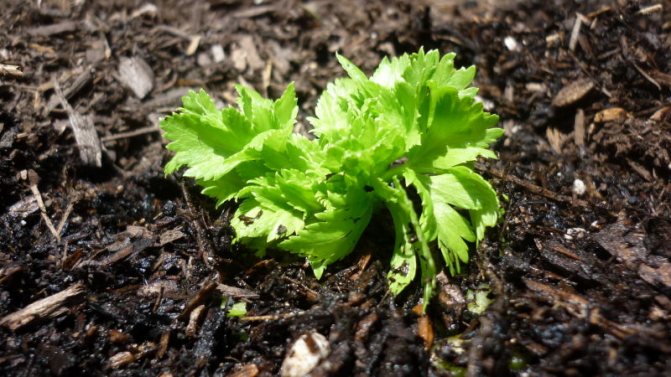

Basic rules for successful cultivation of celery:
- Root celery greens are not cut. Otherwise, not a rounded root crop will form, but a "sponge" from the roots.
- High hilling of the root variety is not practiced, so as not to provoke the growth of lateral roots.
- After the emergence of the root crop above the surface, the soil is raked off and the root processes are cleaned to create a rounded shape.
- Planting celery is watered as the soil dries out, without overflowing. Excess moisture provokes the development of putrefactive processes in the root system.
- Root crops are harvested after the top has dried.
- For growing stalked celery, a soil with a neutral pH = 6.8-7 or slightly acidic pH = 5.6-6.0 is suitable.
- Celery stalk seedlings are planted in areas on the south side of the garden.
- Planting stalked celery is regularly thinned out. Lateral shoots are cut off.
- Two weeks before harvest, the stems are wrapped with paper for bleaching. This celery has a delicate taste without bitterness.
- Plants are fed with potash and nitrogen fertilizers.
- Sowing seeds of leaf celery is carried out after warming up the soil to + 10 ° C.
Varieties
The best varieties of root celery: Albin, Globus, Delicacy, Egor, Esaul, Zvindra, Kaskade, Gribovsky, Maxim, Non Plus Ultra, Snow Globe, Yudinka, Apple.
Popular varieties of leaf celery: Kartuli, Cheerfulness, Zakhar, Gentle, Samurai.
Self-bleaching petiole varieties: Tango, Malachite, Gold, Triumph, Pascal.
Stalked varieties requiring bleaching: Male prowess, Crunch, Utah, Atlant.
The use of celery in cooking
This flavorful vegetable is so versatile that all of its parts can be used to make a delicious meal.
How to prepare celery stalks and leaves:
- Separate the stems from the bunch and wash them in cold water to remove any contaminants, fungicides, and pesticides.
- Since this spice contains a lot of fiber, remove the tough ends of the petioles (the large white section from the bottom of each stem).
- Using a vegetable peeler, peel each stem while holding the base on a cutting board. If the petiole is tender enough, skip this step.
- Cut the celery into pieces of the desired size.
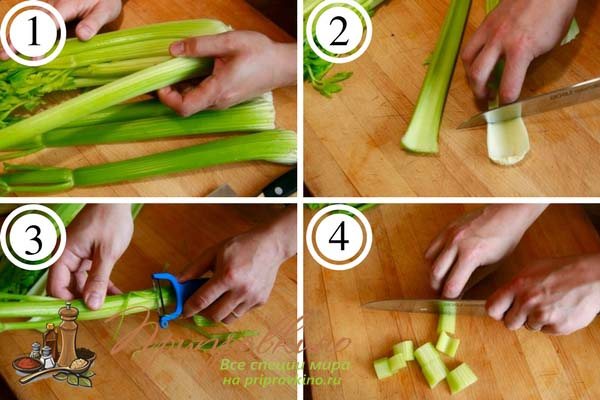

If the celery is a little wilted, you can revive it by soaking it in ice water for an hour.
How to peel celery root:
- Place the celery root on its side on a cutting board and cut the top and bottom off.
- Place the root upright. It must be stable.
- Cut off the remaining peel in vertical strips from top to bottom, following the shape of the root. Continue cutting until all of the skin has been removed.
- Cut the root into cubes or slices and rinse quickly in lemon or orange juice water to prevent discoloration (oxidation).
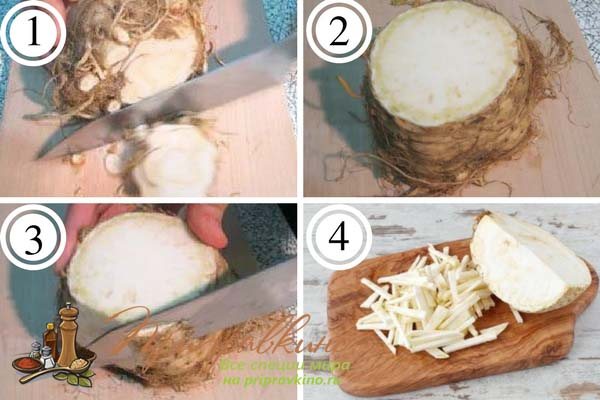

How much celery to add and when
The smell of celery in large quantities can "kill" all other seasonings, so it is added sparingly in the mixture.
Like other fresh spices, it is better to add stalks and herbs to dishes 10-15 minutes before cooking, the stems are coarsely chopped, the leaves are tied in a bunch.
It is more convenient to add celery roots, cut into large pieces, to dishes that require long-term heat treatment, in the middle and towards the end of cooking.
What dishes are celery put in
This flavorful vegetable is so versatile that all of its parts can be used to make a delicious meal. Here are some tips on where to add celery:
- Fresh leaf, root and stems - in salads and stews.
- Celery root vegetable puree soups are very popular.
- Used as a side dish in various dishes. It goes well with vegetables such as potatoes, carrots, legumes, and poultry.
- Fresh leaves, petioles and roots for soups and sauces.
- Use the delicate leaves like any spicy herb: chop finely, pick with your hands or leave whole. Throw them in green salad or vinaigrette, chips, soups and sauces. Decorate the dish with twigs before serving.
- Try celery juice paired with cucumber, cabbage and apple for a refreshing drink. This vegetable adds a vibrant aroma and flavor and is not overly sweet. Also try it in cocktails: it goes well with tequila or gin.
- Fry thinly sliced celery root with chicken, beef, or turkey. It cooks quickly but remains crispy.
- Add chopped root to mashed potatoes for a savory flavor and aroma.
- The best use of frozen celery stalks is for toppings, soups, stews, and sauces. You can add it directly from the freezer to a dish without thawing.
- Grated roots and chopped celery are mixed with chopped bell peppers, carrots, parsley, and 20% salt is added to the total weight of the vegetable mixture. It turns out to be a versatile seasoning that keeps well in the refrigerator. It is used instead of salt for dressing potato and cereal soups.
- Celery seed spices go well with grilled meats (especially pork ribs), tomato and vegetable soups, meat and chicken broths, omelets and marinades.
Celery soup (for weight loss) - video
Celery and apple salad - video
Petiolate
These varieties of celery are grown for the fleshy and juicy stalks. They are consumed fresh, cooked, processed by all known methods.
Malachite
Medium early grade. It reaches technical ripeness in 80-90 days. The height of the plant is 0.4 m. The foliage is rich green, and the petioles are of a light green hue. "Malachite" is distinguished by thick and fleshy petioles. The plant weighs 0.7-1.2 kg. Good taste and pleasant, spicy smell. The foliage and petioles are eaten fresh, dried, frozen.
Cold resistance. Minus 5 ° C is a temperature that is safe for Malachite. Demanding on the care and composition of the soil. Needs regular watering. When grown as seedlings, the seeds are sown at the end of February. Seedlings are planted when they reach a height of 12-15 cm and have 3-5 leaves. The landing pattern is 60x20 cm. From 1 sq. m receive up to 4 kg of greenery - leaves and petioles.
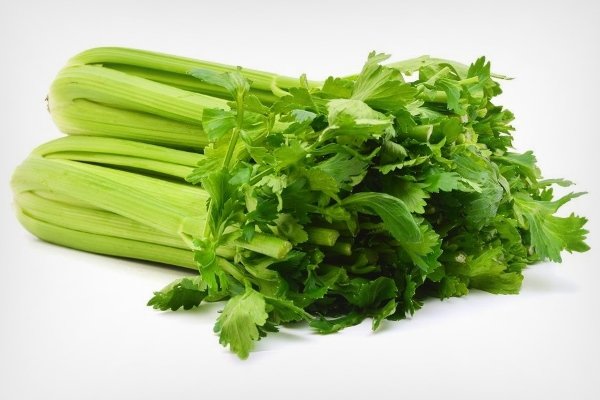

To determine the freshness of the stalked celery, break the stalk - if you hear a crunch, the product is fresh.
Gold
Yielding mid-season variety with good taste and strong odor. Vegetation - 160-170 days. Plant weight - 0.8 kg. Petioles are golden-green. For salads and cooking. The petioles retain their freshness for a long time, they can be frozen.
Self-bleaching grade. Productivity - 5 kg / sq. m. To make the petioles white and tasty, the plant is spud up in the second half of summer. Planting scheme - 60x30 cm. Sowing in late February-early March. Planting of seedlings - in the first half of May. They sow in unprotected soil in the second half of spring.
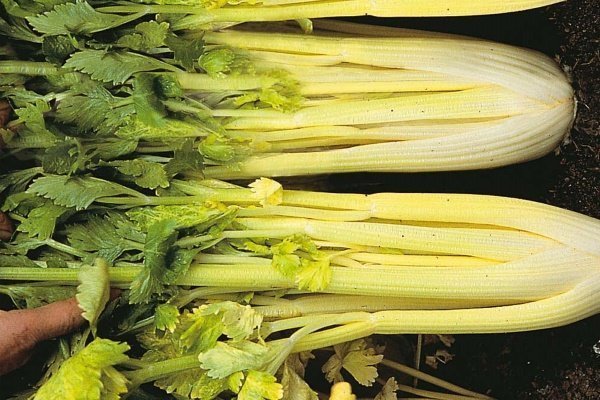

Pascal
From mid-season varieties. Requires bleaching. Ripens in 100 days. Productivity - up to 4 kg / sq. m. Plant weight - up to 0.5 kg. The petioles are rich green, their length is 20-22 cm. They are consumed fresh, canned, added as spices to various dishes.
For seedlings, seeds are sown in mid-March-early April. Planting seedlings in the ground - the end of May, when the plant will have 5-6 leaves. The planting scheme is 35x40 cm. 3-5 kg of greens are grown on one square meter. To improve the quality of the petioles, they are bleached 2 weeks before harvesting by shifting and wrapping them with a paper sheet.
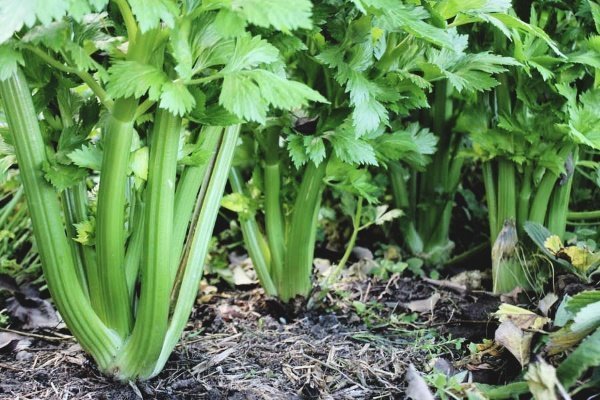

Triumph
From mid-late varieties. Suitable for growing in unprotected ground. Height up to 0.65 m. Leaves length - 30 cm. Petioles are emerald green, juicy, fleshy, with a delicate aroma.
Reaches technical ripeness in 130 days. Productivity - 4 kg / sq. m. Petioles are used for salads, soups, added to various dishes.
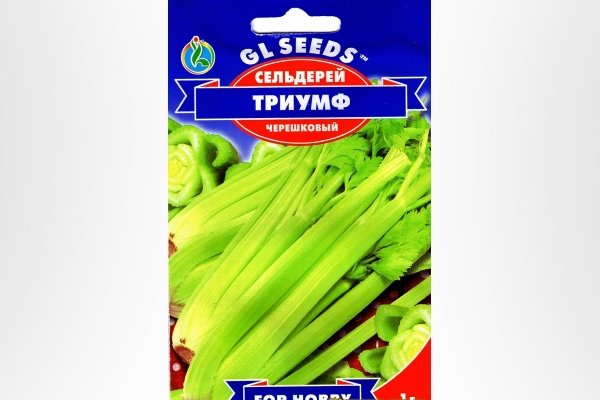

Tango
The variety is fruitful, from mid-season. The growing season is 170 days. The petioles are long - up to 50 cm. The color is bluish-green, there is no coarse fiber. The plant weighs up to 1 kg. The variety is distinguished by high aroma, retains its presentation for a long time, the pulp has an excellent taste, it is tender and juicy.
Requires watering, loosening and feeding. Productivity 2-4 kg / sq. m. They are planted with a wide-row method. Row spacing - 45-50 cm. Seed depth - 0.5 cm. Resistant to low temperatures.
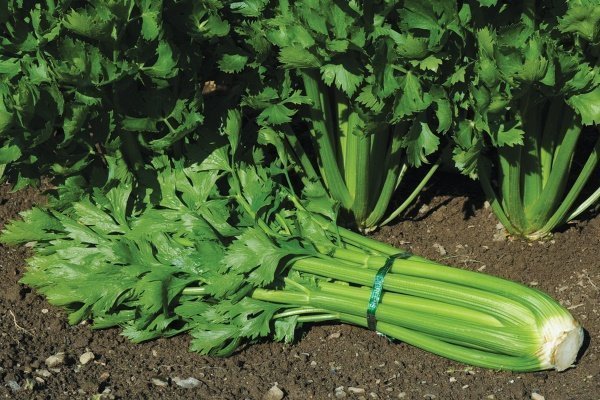

Anita
A variety of Italian selection. Very tasty. A plant with an erect rosette, its height is 60-65 cm. The petioles are green, very juicy and crunchy, with an excellent aroma, not fibrous. From 1 sq. m it is easy to pull up to 3-4 kg of petioles.
The growing season, from germination to technical maturation - 90 days. Used as a seasoning for dishes, eaten fresh and canned. Keeps presentation for a long time. The height of the bush is 30-60 cm. High resistance to frost. Growing - seedling and seedling type.
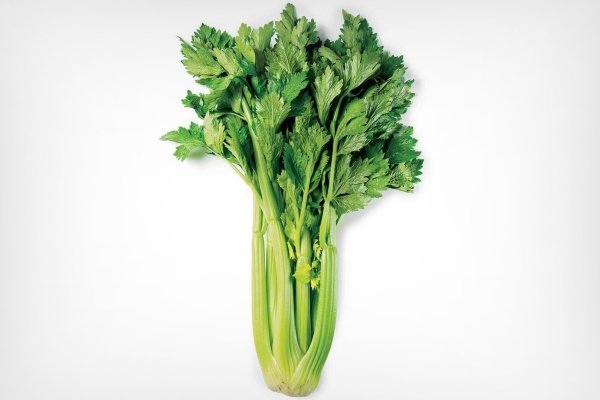

Celery is a superfood for weight loss. It contains special fiber, in 100 g - only 16 kcal. But most importantly, digesting celery, the body spends many times more energy than it receives.
Atlant
From mid-season varieties. Ready to consume in 160 days. The rosette is straight, its diameter is 45 cm, height is 40 cm. The leaves are medium-sized, green, glossy. Petioles are medium in size, green, with a slightly ribbed surface. The weight of the petioles from one plant is 0.3-0.4 kg.
Growing is seedling. Requires bleaching - to improve the palatability of the petioles. For two weeks, the petioles are wrapped in paper. Productivity from 1 sq. m - 2.8-3.3 kg. Planting scheme 35x40 cm. The variety is responsive to fertilizing - humus, manure, ash, complex fertilizers. Mulching with humus is practiced. The plantings are loosened and watered.
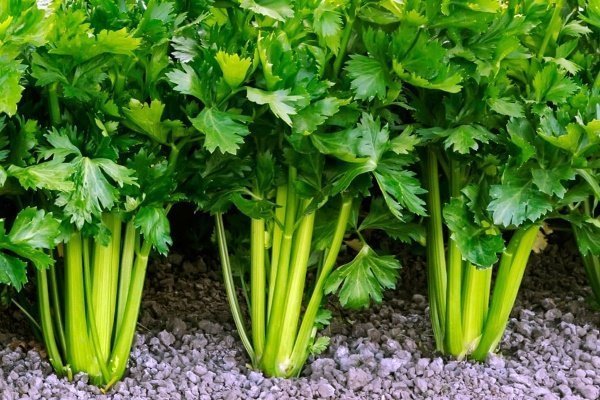

Male prowess
Early ripe variety. Ripening - 150-165 days. The socket is strong, erect. Leaves are medium-sized, green, glossy. Plant weight - 0.75-0.8 cm. Petioles are thick, fleshy, light green, fragrant. The weight of the petioles is up to 0.65 g. The length of the plant is 55 cm. It is eaten fresh, pickled, canned, added to salads.
Seedling planting scheme: 20x50 cm. Productivity from 1 sq. m - 3.3-3.8 kg. Cultivated outdoors. Good presentation and high taste.
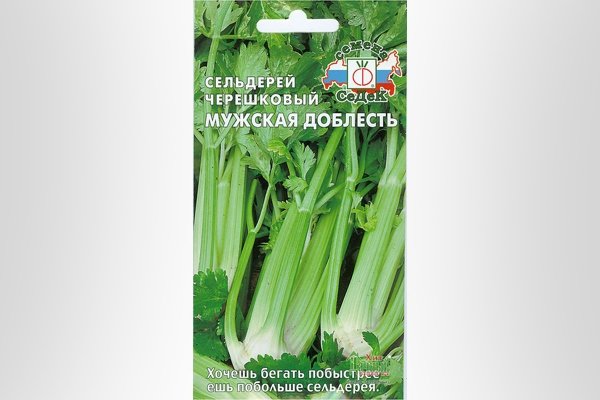

How to replace celery in recipes
- 1 medium petiole, no leaves = ½ cup coarsely chopped or chopped greens = 40 g dried celery.
- 30 grams of chopped celery = 4 tablespoons = ¼ cup.
- 1 cup finely chopped celery = 125 g
- 10 tablespoons dry celery powder = 60 g.
Celery is well known for being low in calories, but its health benefits go far beyond being used as a diet food. By including celery in your diet, you will not only lower your risk of cancer, but you will also prevent many other health problems due to its many benefits.
What internal content does celery boast
Celery can boast of all its main beneficial qualities solely due to its internal or chemical composition. What does this plant consist of in more detail:
- Vitamins: A, B, C, E, K;
- Acids: ethavdiic, organic;
- Chemical elements: iron; calcium; magnesium; phosphorus;
- Other elements: sugar, salt, protein, essential oil;
And now let's take a closer look at the specific benefits of this amusing vegetable.
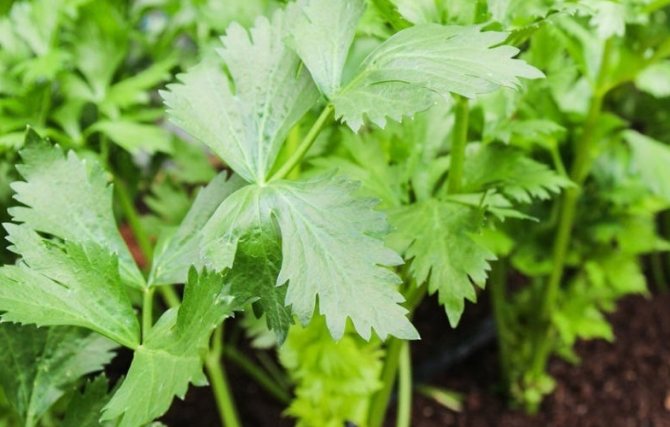

Planting seedlings in the ground
It is possible to plant celery seedlings in open ground after the establishment of relatively warm weather. In most parts of our country, the best time for a transplant is mid-May. The bed should be in an open, sunny place. 2 weeks before planting, 250 g of dolomite flour and 40 g of nitroammofoska (1 m2) are added to the soil and dug up. In the absence of rain, the garden must be watered to dissolve the fertilizer.
The holes are dug at a distance of 35 cm from each other, 40 cm are left between the rows. Seedlings are planted by squeezing the ground around the seedlings, watering and mulching the soil. It is very important not to bury the plants. The growth point (the center of the rosette) must be above the ground, otherwise the young leaves will not be able to break through to the light, and the plant will die.
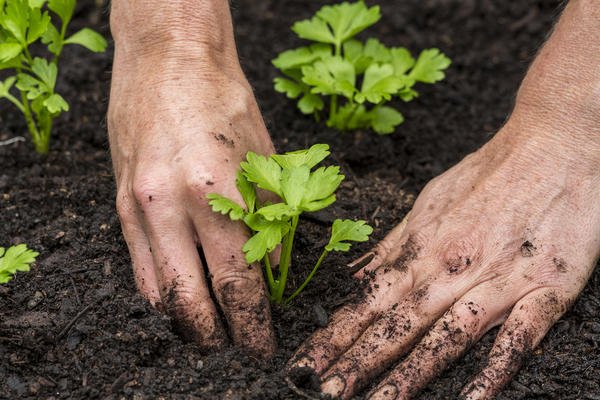

It is better to plant celery seedlings in the garden in cloudy weather or in the evening
There are no plants in our gardens that could oppress celery or have a negative effect on it. Onions, beans, cabbage or tomatoes planted nearby can improve its growth, and celery, in turn, will scare off some harmful insects that bother neighbors with a strong aroma. Unwanted predecessors are carrots and beets.
Recent Entries
Rose Petal Jam and Its 7 Health Benefits You Likely Didn't Know About What Fruit Are You According to the Zodiac Sign The 11 Best Grape Varieties That Will Help You Create Unique Homemade Wine
Video: planting celery
What varieties to choose for different growing regions
There are several climatic zones in our country, therefore, when choosing a variety for planting, the timing of its ripening is taken into account: early, mid-ripening, late.
In the central and southern regions, it is customary to grow early and late varieties. The early ones will go to sell greens on the market, the later ones will have time to ripen and will be well stored.
In the northern regions, only early and mid-season varieties are traditionally planted. Due to the onset of cold weather, the late ones do not ripen. Too early varieties are not planted either - they fall under frost. But if you plant them in a greenhouse and observe the cultivation conditions, the harvest is the same as in central Russia.
For the Urals and Siberia, varieties are suitable: from root - Russian Size and Egor, from leaf and petiole - all of the above.
For central Russia, northeastern and central regions: from the root - Diamant and Yablochny, from leaf and petiole - all the varieties listed above.
Varieties
In nature, there are three types of this vegetable:
Each of these species is grown for its intended purpose. Leaves are collected from leaf celery, which are rich in vitamins. They can be harvested throughout the season: from early spring to late autumn. Succulent petioles are harvested from the stalked celery species. Harvesting time falls at the end of summer, beginning of autumn. Juicy root vegetables will delight the gardener with the root type of celery. They begin to collect them in the fall. Moreover, one such product weighs from four hundred to eight hundred grams. In addition, leaves can be collected from this species.
Seedling care
With the appearance of two true leaves, celery seedlings can be cut into separate pots. For these purposes, plastic disposable cups or special cassettes for seedlings with a capacity of 150-200 mg are suitable. Before picking, the seedlings must be watered so as not to injure the roots of the plants.
Dive sequence:
- Fill prepared containers with soil and compact it slightly.
- Use a stick or pencil to make a depression in the center of the cup.
- Pick up a celery seedling with a stick, carefully pull it out and transfer it to a separate glass.
- Lower the root into the hole and squeeze the earth around it.
- Water the seedlings, and, if necessary, add soil without deepening the sprout.
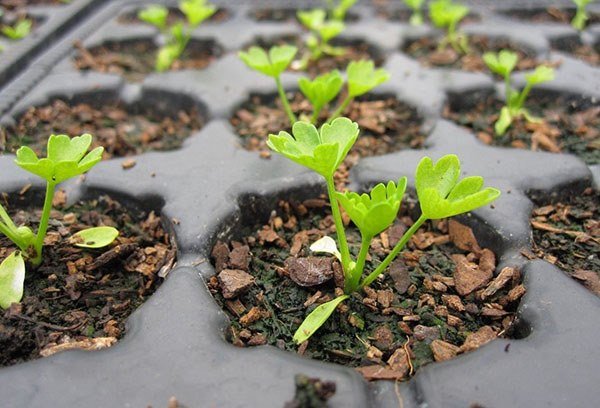

When diving, the growing point of the celery rosette must remain above the soil surface
The cut seedlings should be placed in a bright, cool place. It is necessary to water the growing seedlings regularly, but extremely carefully so that the delicate sprouts do not damage the water jet. An ordinary medical syringe is best suited for this.
Rooted seedlings must be fed. This usually happens 7-10 days after the pick. You can use an aqueous solution of nitroammofoska, but the concentration should be 2 times weaker than for adult plants. Therefore, for 1 bucket of water, 0.5 tbsp will be enough. l. fertilizers. You can feed seedlings only in the morning and on wet soil. If the soil in the containers is dry, preliminary watering is required.
Before planting seedlings in the ground, it is necessary to harden the plants for 2 weeks. To begin with, they take the containers out into the garden (or onto the balcony) for 15–20 minutes.This should be done in the morning or evening hours so that the delicate leaves do not fall under the scorching sun. Every day, the exercise time is increased so that by the time of planting, the seedlings can be in the air all day.
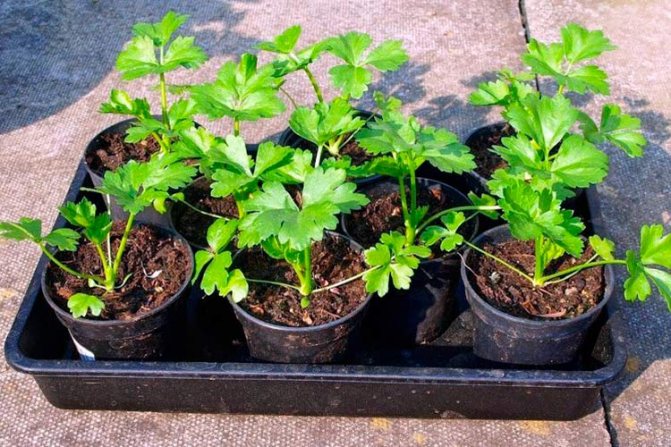

The grown hardened seedlings can be planted in open ground
Precautions
Celery root, the benefits and harms of which must be taken into account when using it, has some contraindications. The negative effect of the vegetable on the body for pregnant women (after the sixth month in particular) and nursing mothers has been known for a very long time. Research has shown that a green plant produces a lot of gas. This has a negative effect on the fetus and the condition of an already born child who feeds on mother's milk.
Surprisingly, the harm of the vegetable is also manifested in its negative effect on the brain of a person with epilepsy. To refrain from excessive eating of celery root is recommended for those who suffer from varicose veins, thrombophlebitis and hyperacid conditions. In addition, people with urolithiasis should limit the use of this plant, since it causes active movement of kidney stones, and this is an indisputable fact. Regular intake of this root in food led to the need for surgical intervention. But for a healthy body, such a negative effect is not significant. However, in everything you need to observe the measure.
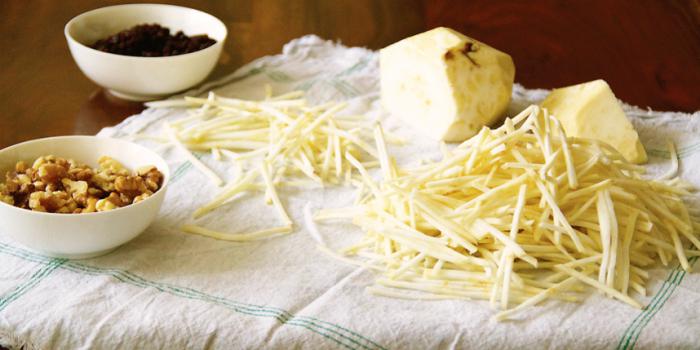

Based on the foregoing, we can conclude that the celery root, the benefits and harms of which are undoubted, should be eaten rationally. If you doubt whether you can eat this healthy vegetable, consult with experts.
Reproduction
Reproduction of celery occurs thanks to the seeds, but they do not germinate for a very long time. For this reason, they are sown in advance to grow seedlings. In addition, this method of planting celery contributes to an excellent harvest. It should be noted that the seeds of this culture have an unusual feature. They become of higher quality and have a better similarity if they are stored for several years. At the same time, the seed that has lain for three or even four years will sprout faster than the one collected this year. But this can only be used when the seeds are harvested on their own. Nobody can reliably say anything about those sold in the store.
Celery compatibility with other products
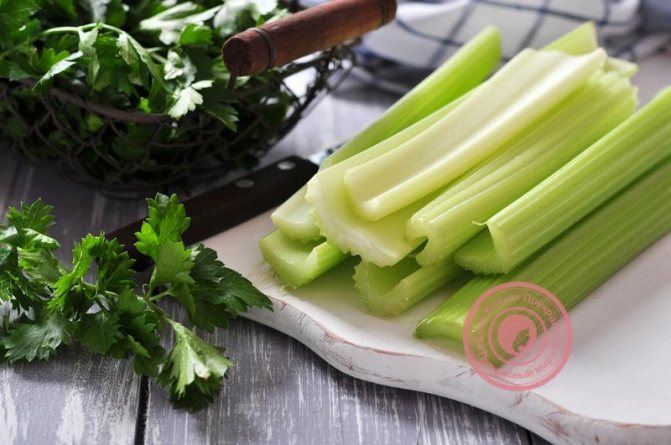

So, celery juice + juice:
- watermelon (cleans the kidneys and bladder);
- orange (normalizes high blood pressure);
- apples (neutralizes the acidic environment in the body);
- cucumber (replenishes vitamin A deficiency);
- grapefruit (helps with stomach ulcers);
- lemon and sea buckthorn (debugs the thyroid gland);
- parsley (relieves heat and serves as a good prevention of arthritis);
- carrots (strengthens the immune and nervous system).
gifts of nature
Growing greenery on a windowsill
Celery can be grown year round at home on a windowsill. Seed preparation and sowing are the same as for open ground, and fertilizing is done as for seedlings. To obtain greenery for cutting, it is necessary that the window or balcony face the sunny side. In winter, the planting will have to be supplemented with a phytolamp.
The optimum temperature for indoor growing of celery is 15-18 ° C. If it is warmer and the lighting is insufficient, the seedlings will stretch out and be thin and frail. It is necessary to water the plants with settled water at room temperature.
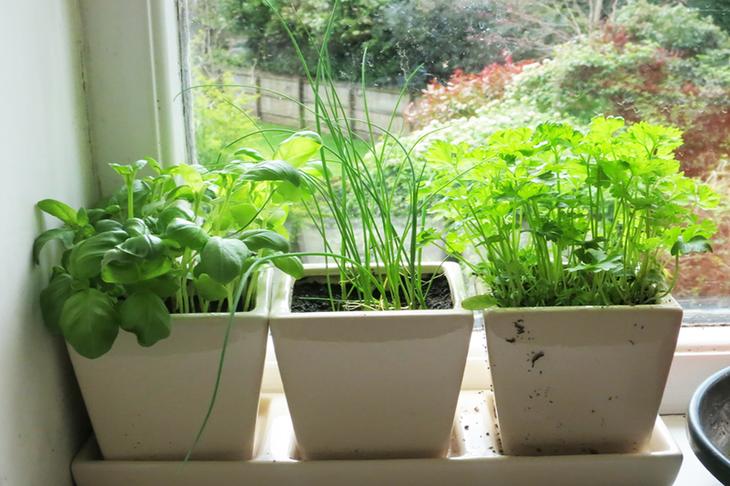

Celery and other representatives of spicy greens feel good in pots on a light windowsill
And it will fix your nerves ...
Celery has a positive effect on our nervous system. The so-called stress hormone is present in human blood. The substances that make up the plant in question soothe and calm us.This is due to a significant decrease in the content of this hormone in the blood. Therefore, instead of resorting to the use of a sedative, you can simply eat a little magic vegetable or drink the juice obtained from it.
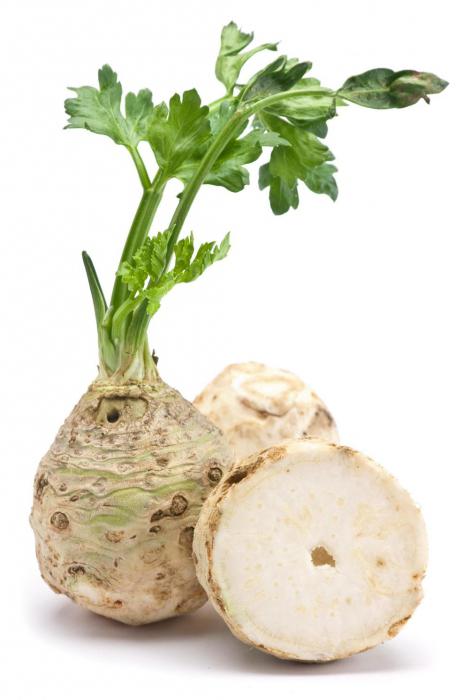

Choosing a landing site
Celery loves sunny areas. But it can also tolerate partial shade. At the same time, its greens become more aromatic.
The soil should be loose and contain enough nutrients. Acidic soil should be limed. The predecessors of celery can be any vegetable crops, except for umbrella crops (carrots, beets, etc.).
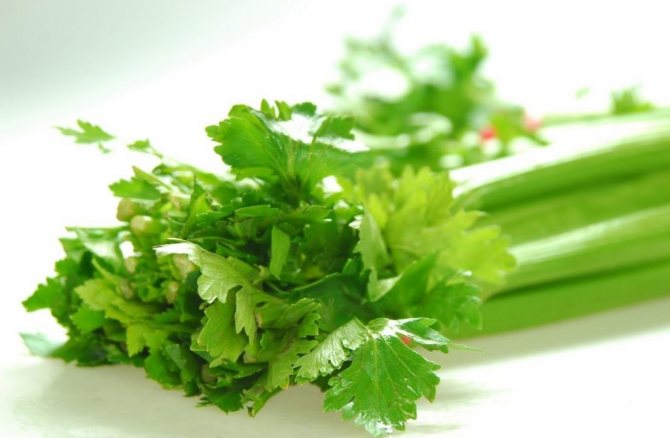

Selera can be planted in a shaded area to get more flavorful greens.
This is due to the fact that these vegetables can have the same diseases and pests.
It can also be planted between beds with other plants:
- onions
- potatoes
- cucumbers
- garlic
- cabbage, etc
back to menu ↑
See also: Kalina Krasnaya berry: and its beneficial properties and contraindications, as well as 13 folk recipes + Reviews
Applying
Celery is a culture in which all parts of the plant are eaten
Its vegetative parts are bittersweet to taste. They have a pleasant aroma. The taste may vary depending on the variety. Roots, vegetable seeds can be dried, applied fresh. Leaves - freeze.
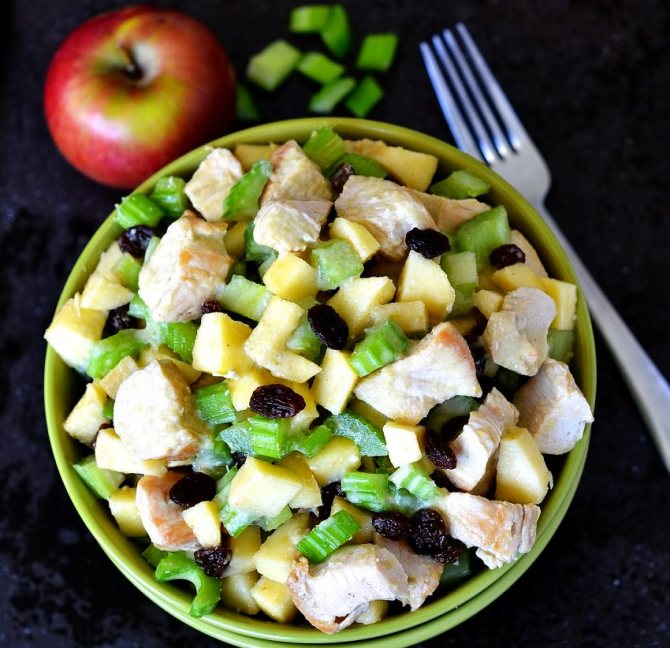

Selera can be consumed fresh, dried, pickled
The dried parts are included in the spice mixture. Celery stalks are stewed, fried, and salads are prepared from it.
It is believed that celery is best added to vegetable dishes from:
- eggplant
- cabbage
- beans
- tomato
- potatoes
- carrots
Vegetables are often combined with meat, mushrooms, fish. The root vegetable is able to improve the taste of sauces, soups, egg dishes, salads.
The seeds are used to make celery salt, or to add cooking aroma.
Celery is a low-calorie product... 100 g of stems, leaves contains only 12-16 kcal, roots - 32 kcal. Therefore, it is often used for dietary nutrition.
A vegetable can be consumed no more than 150 g per day.
back to menu ↑
See also: Pomegranate at home: growing from seeds and care, useful properties and contraindications + Reviews
Calorie content, composition and glycemic index
Celery is a two-year plant culture that has been used by humans since ancient times. The ancient Egyptians and Romans used the plant as a medicine, making all kinds of preparations and decoctions from it. This vegetable began to be added to food a little later, however, very soon it gained immense popularity.
In ancient times, this vegetable was called "the cure for all diseases", and it really is. The plant is used for prophylaxis in the treatment of many diseases. Celery is recognized as an effective anti-cancer agent, because it can significantly slow down the development of the disease.
Sowing seeds for seedlings
Celery seeds germinate for a long time, and the plant itself develops slowly. Even in early maturing varieties, the period for cutting greens occurs, at best, 2.5 months after germination. To shorten outdoor growing times (or to get an early harvest), celery is grown through seedlings. The best time for sowing seeds is late February or early March.
Video: growing celery
Seed and soil preparation
Celery seeds intended for sowing are soaked in water at room temperature for 2-3 days. Before soaking, it is advisable to pickle them in a strong solution of potassium permanganate:
- The seeds are wrapped in a cotton napkin, placed on a saucer and poured over with a solution.
- Then the napkin is washed in clean water and left in a wet state for several days.
- It is advisable to cover the saucer with a plastic bag so that the water does not evaporate.
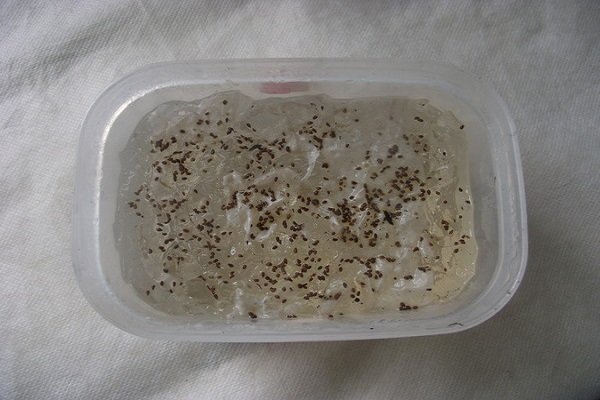

When soaking seeds, it is important to prevent moisture evaporation, so it is better to cover the container with polyethylene
Before sowing, the seeds must be well dried. For convenience, they are mixed with dry river sand.
You can prepare the soil yourself or buy ready-made soil for seedlings. It is important to consider that celery does not like an acidified environment, and the finished soil, most often, contains peat, that is, an acidic component. Therefore, it is advisable to add a deoxidizer - dolomite flour or ash in the amount of 20–30 g per 1 kg both to the store and to the mixture of your own preparation. When self-preparing the soil for 3 parts of garden soil, take 1 part of compost and sand, add 0.5 parts of vermiculite or coconut substrate - for friability.
Sowing subtleties
You can sow celery seeds for seedlings in any plastic containers. It is important not to forget to make drainage holes in the bottom of the tank so that excess water does not accumulate and sour.
Step-by-step process of sowing seeds:
- Fill the container with prepared soil.
- Sow seeds mixed with sand in rows at a distance of 5–6 cm from each other.
- Sprinkle them with a thin layer of soil and spray with water from a spray bottle.
- Cover the container with a plastic bag and place in a warm, bright place.
After 2-3 weeks, the first shoots will appear, and the bag can be removed. To prevent the seedlings from stretching, they are rearranged to a cooler place (with a temperature not higher than 18–20 ° C). Growing plants must be sprayed on time, preventing the soil from drying out.
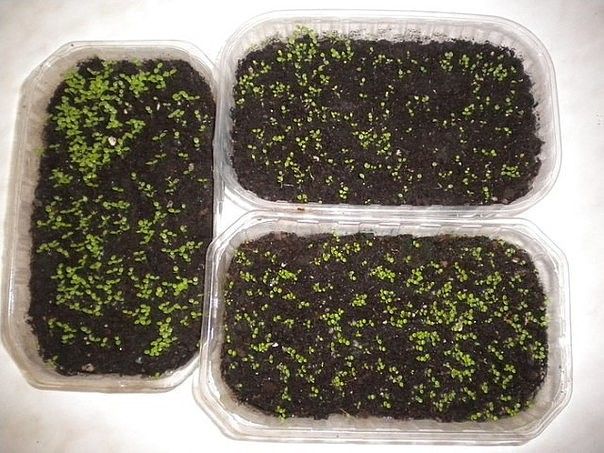

After emergence, containers are rearranged in a bright, cool place.

